Knee pain can be one of the most unbearable experiences you might ever endure, and you would likely do anything to alleviate it. Fortunately, the resolution of chronic knee pain is difficult but not impossible. You can pursue several avenues to help relieve some of the pain you are feeling because of a chronic condition.
To clarify, one of the best things to do when suffering from chronic knee pain for the first time is to seek out professional medical assistance to diagnose the cause. Still, once you have been diagnosed, there is one approach to alleviating the pain that is becoming more and more popular. Stretching. Regularly employing stretches that work the affected part of your body can help you overcome the pain. The real trick is figuring out which exercises are best for your pain.
The Source of the Pain
The first step to understanding how to treat your pain is figuring out what is causing it in the first place. Stretching will only help with certain conditions, with other more severe chronic conditions being completely unaffected by any exercise.
If the source of your pain is the result of recently undergoing surgery, suffering an injury, or even simply arthritis, stretching can help increase your range of motion while also mildly alleviating the pain you feel. Ordinarily, you might consider exercising an arthritic leg to be less than ideal as the condition is deeply rooted in genetic factors. However, exercising an arthritic leg is a good idea since keeping the knee still can worsen the stiffening and compound your pain further. Obviously, you need to be careful when it comes to exercising a leg suffering from arthritic conditions since overexertion will make it worse. It’s a delicate balancing act.
There is no shortage of conditions that cause you to suffer from chronic pain in your knee:
- Menisci Injury: The menisci are a pair of cartilages shaped like a ‘C’ located in the joint of your knee. The menisci’s raison d’être is to absorb kinetic damage to the knee bone and help minimize the pain you feel. The menisci, as a result, are prone to being damaged or torn and resulting in chronic pains and aches that make everyday tasks a hassle.
- Ligament Injury: Ligaments are fibrous bands that keep your bones connected. The ligaments in your leg connect the femur to the tibia by running through the knee. As a result, when the ligament tears, you experience intense and nearly crippling knee pain.
- Arthrofibrosis: Otherwise known as “stiff knee syndrome,” arthrofibrosis is the result of an excess of scar tissue forming around the joint of your knee. Arthrofibrosis is a common consequence of knee surgery that promotes the generation of scar tissue as part of the healing process.
- Arthritis: Arthritis is a condition that comes in many forms and is caused by anything from an autoimmune disorder to repeated physical trauma to a particular part of the body. While arthritis requires more demanding treatment in all its forms, it is one of the more common issues that exercise can occasionally help with.

No matter who you are, understanding the source of your pain is paramount to finding the best way to treat it. If you apply a blanket measure to a hurt knee without being sure of why it is in pain, you might wind up doing more harm than good when it comes to healing. As for the knee stretches you can use to help strengthen and heal, several variations offer different benefits.
Stretches and Exercises
When working to heal your knee from the chronic condition you are suffering from, one of the main focuses is reinforcing your knee to be more resistant to the pain by default. By performing strengthening exercises, you can reinforce your joints and muscles that allow your knee to resist the pain and withstand strain more easily. The American Academy of Orthopaedic Surgeons offers guidelines for a full program that lists several stretches and exercises that can help you reinforce your muscles and joints.
The ten stretches listed below will help to strengthen your knee joint. However, you should always consult with your doctor to make sure they won’t aggravate an injury or worsen your pain. If you have the approval to stretch, you can do these at home or with the assistance of a physical therapist.
1. Heel Cord Stretch: The heel cord stretch is an exercise that allows you to work your calf and heel. For this exercise to work, you need to perform three sets of four stretches, six to seven times a week.
-
- Face a wall with your healthy leg forward and slightly bent at the knee. Keep the afflicted leg straight and behind you with the heel flat and your toes pointed in.
- Keep both of your heels flat and press your hips forward in the direction of the wall.
- Hold for 30 seconds and then relax for 30 seconds before repeating.

2. Standing Quadriceps Stretch: This exercise focuses on the front of your thigh and requires you to perform two sets of three stretches, four to five times a week.
-
- Balance yourself using a chair or the wall.
- Bend your knee and move your heel up to your rear.
- Hold your ankle and gently pull it closer to your body.
- Hold for 30 to 60 seconds before repeating with the other leg.

3. Supine Hamstring Stretch: This exercise focuses on the back of your thigh and knee and is designed for two sets of three stretches four to five times a week.
-
- Lie down on the floor and bend both of your legs.
- Lift one of your legs from the floor and bring your knee in towards your chest while holding your hands behind your thigh just under the knee.
- Straighten the leg and gently pull it in the direction of your head.
- Hold for 30 to 60 seconds before repeating with the other leg.
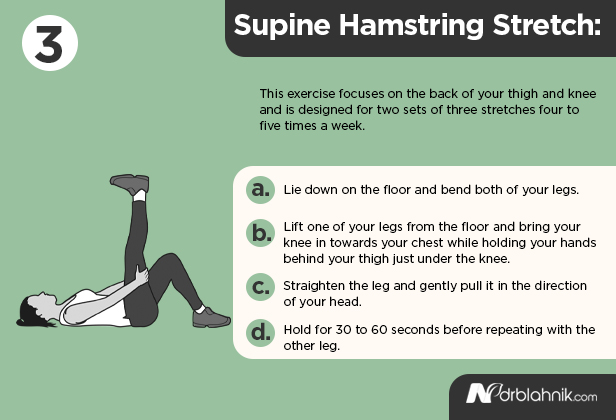
4. Half Squats: This exercise focuses on tending to your quadriceps, glutes, and hamstrings and requires repetitions of three sets of ten stretches, four to five times a week. Unlike the other stretches listed thus far, this one requires you to eventually employ the use of weights of up to 10 lb. yields.
-
- Stand with your feet separated at shoulder length. Your hands can be rested on the front of your thighs, outstretched in front of you, or used to hold onto a chair for balance.
- Keep your chest elevated and slowly lower your hips by 10 inches until you are in a sitting position.
- Lean your weight into your heels and hold for five seconds.
- Push with your heels to bring your body back into a standing position.
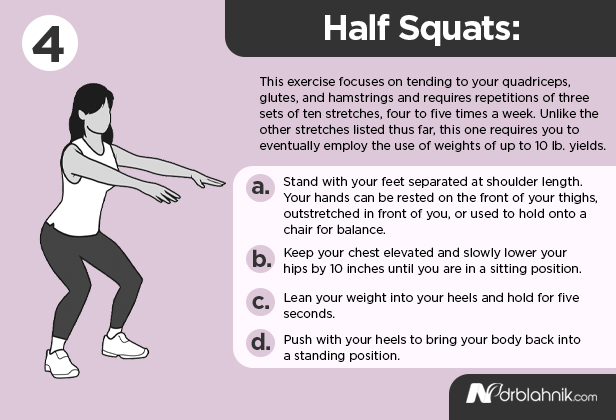
5. Hamstring Curls: This exercise focuses on the back of your thighs and requires you to perform three sets of ten stretches, four to five times a week. Like the previous exercise, you will need to add extra equipment. Specifically, ankle weights up to a maximum of 10 lbs.
-
- Hold onto the back of a chair or wall for balance.
- Bend the afflicted knee and raise your heel as far as you can without feeling any pain.
- Hold for five seconds, relax, and then repeat.

6. Calf Raises: This exercise focuses on your calf and requires repetitions of two sets of ten stretches, six to seven times a week.
-
- Stand with your weight distributed across both of your feet while holding on to a chair or wall for balance.
- Lift your healthy foot off the floor and transfer all your weight onto the afflicted foot.
- Raise the heel of your foot as high as you can before lowering it again and repeat ten times.

7. Leg Extensions: This exercise focuses on the front of your thigh and requires repetitions of three sets of ten stretches, four to five times a week. This exercise will require you to add ankle weights up to a maximum of 10 lbs.
-
- Sit up on a chair or bench.
- Tighten your thigh muscles and slowly straighten and raise your afflicted leg as high as you can.
- Squeeze your thigh muscles, hold for five seconds, relax, return your foot to the floor, and repeat.
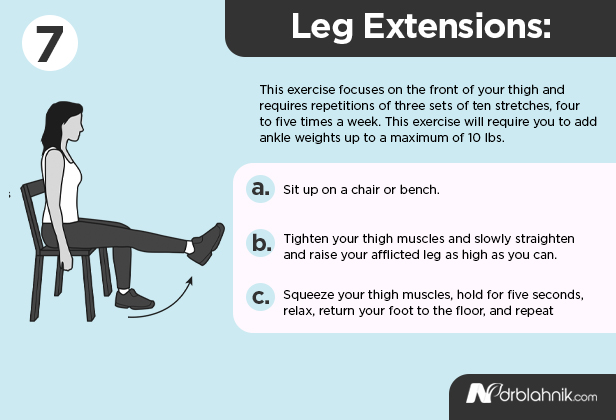
8. Straight-Leg Raises: This exercise focuses on the front of your thigh and requires repetitions of three sets of ten stretches, four to five times a week. This exercise will also require you to eventually incorporate ankle weights up to a maximum of 10 lbs.
-
- Lie on the floor with your elbows directly beneath your shoulders to keep your upper body well-supported.
- Keep the afflicted leg straight and bend your healthy leg so that your foot is pressed flat on the floor.
- Tighten your thigh muscle in the afflicted leg and slowly raise it 6 to 10 inches off the floor.
- Hold for five seconds, relax, bring your leg back to the floor, and repeat.

9. Straight-Leg Raises (Prone): This exercise focuses on your hamstrings and glutes and requires repetitions of three sets of 20 stretches, four to five times a week. This exercise requires you to incorporate ankle weights of up to a maximum of 10 lbs.
-
- Lie on your stomach with both of your legs straightened with your head rested on your arms.
- Tighten your glutes and hamstring muscles in the afflicted leg and raise it as high to the ceiling as you can.
- Hold for five seconds, lower your leg, rest it for two seconds, and repeat.
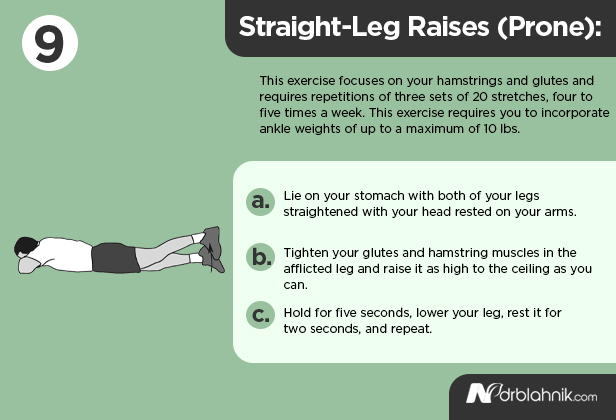
10. Hip Abduction: This exercise focuses on your thighs and rear and requires repetitions of three sets of 20 stretches, four to five times a week. This exercise will also require you to eventually incorporate ankle weights up to a maximum of 10 lbs.
-
- Lie on your side with your afflicted leg on top of your healthy one, which will be bent to support the other.
- Straighten your top leg and slowly raise it to a 45-degree angle with your knee straightened without locking it.
- Hold for five seconds, slowly lower your leg, relax it for two seconds, and repeat.
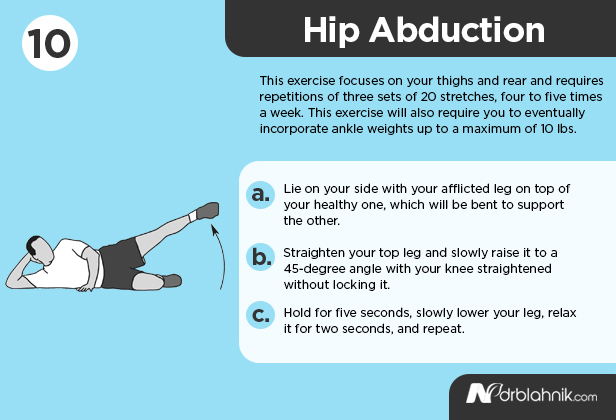
These exercises won’t always solve the chronic pain you are experiencing but can serve as an excellent way to mitigate the pain and give your knee more time to heal. Many of these exercises require you to begin using ankle weights to get the best results but can further be supplemented with additional equipment.

If you feel you will need additional help in maximizing the benefit of your exercises, consider adding a resistance band to your equipment that can serve as a major benefit to your healing stretches. Resistance bands are modular pieces of workout equipment that help further strain your muscle to reinforce them when they recover from the exercise. In so doing, the muscles reform stronger than when you first started and help prevent the pain you were feeling from returning as intensely.
The Point
Knee pain is an extremely common issue that plagues almost everyone at some point in their lives. While it is an unpleasant situation that causes no small amount of pain and grief, it is not an issue you need to resign yourself to.
It is true that in many cases, the pain you are experiencing comes from an overarching condition that may require more intensive medical treatment to resolve effectively. Certain chronic issues, like arthritis, can be tended to with regular stretches and exercises but not fully resolved due to how deeply it affects you. Other issues, such as injury or inflammation, can be fully healed by stretching and reinforcing the afflicted muscles and ligaments.
The use of resistance bands can further increase the odds of your recovery and strengthening the afflicted areas to ensure the pain is not only mitigated but permanently reduced as it becomes more and more used to the strain. Ultimately, your medical professional should direct the healing process, but these stretches can help increase the efficacy of the healing process.
What are your thoughts? Have you ever had to overcome chronic knee or ankle pains? What did you do about it to feel better? Did you use any of these stretches? Be sure to leave us a comment down below telling us your story!




